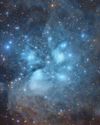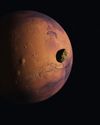
Our understanding of the workings of the universe is better than it has ever been, but there are still a number of misconceptions that manage to fool many of us. Some of the following might sound plausible, but barely any of it is true: the Sun is a burning orb of yellow fire and the temperature is higher during the summer months because we orbit closer than we do in winter. Mercury is the closest planet to our star and must therefore be the hottest.
The lunar phases are caused by the shadow of Earth and at night we can only see one side of the Moon, so the other must be in perpetual darkness. The stars form patterns with their close neighbours and are grouped into local constellations. The twinkling light that they produce travels to Earth in a straight line, unaffected by the pull of gravity. Comets race past with their tails pointing back towards the direction that they came from, and as meteorites tumble through the atmosphere, they heat up so much that it’s not safe to pick them up from the ground.
In space, astronauts experience zero gravity and the only human-made object they can see is the Great Wall of China. Friction on re-entry heats their spacecraft to thousands of degrees, and if the astronauts were unfortunate enough to have a collision in space, it would make an audible bang. Any astronaut exposed to the vacuum of space without a spacesuit would explode due to a pressure imbalance. Saturn is the only planet with rings, but in order to reach it you have to travel through the asteroid belt, which is so packed with rocks that it is like a minefield. And watch out for black holes, because they’ll suck you straight in.
1 BLACK HOLES SUCK
This story is from the Issue 134 edition of All About Space UK.
Start your 7-day Magzter GOLD free trial to access thousands of curated premium stories, and 9,000+ magazines and newspapers.
Already a subscriber ? Sign In
This story is from the Issue 134 edition of All About Space UK.
Start your 7-day Magzter GOLD free trial to access thousands of curated premium stories, and 9,000+ magazines and newspapers.
Already a subscriber? Sign In

MYSTERIES OF THE UNI WHERE ARE ALL THE SPIRAL GALAXIES?
There are far fewer spiral galaxies than elliptical ones in the Supergalactic Plane, and scientists are keen to discover why

ZOMBIE STARS
+10 OTHER TERRIFYING SPACE OBJECTS

HOW TO BEAT LIGHT POLLUTION
Thought it was impossible to observe the wonders of the night sky from towns and cities? Think again. Follow our tips and tricks on successfully observing through sky glow

15 STUNNING STAR CLUSTERS
These beautiful stellar groupings are spattered across the cosmos

Eileen Collins "It was a difficult mission...we were the first to see Mir"
Having served as both the first female pilot and first female commander of NASA's Space Shuttle, Collins boosted the involvement of women in space exploration to a whole new level

MARS LEAKS FASTER WHEN IT'S CLOSER TO THE SUN
The Red Planet has lost enough water to space to form a global ocean hundreds of kilometres deep

FUTURE TECH KANKOH-MARU
This ambitious reusable spacecraft will be capable of taking 50 people to and from orbit

THE FINAL FRONTIER
Beyond the reach of the Sun is a fascinating region of the cosmos that were only just beginning to explore

A long-lost moon could explain Mars' weird shape and extreme terrain
A long-lost moon could explain why Mars is so different from the other rocky planets in the Solar System. Today Mars has two tiny moons.

A sprinkling of cosmic dust may have helped kick-start life on Earth
Cosmic dust may have helped kick-start life on Earth. New findings challenge a widely held assumption that this wasn't a plausible explanation.